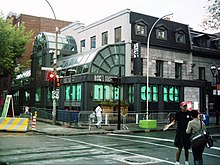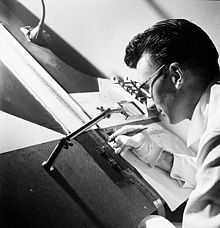National Film Board of Canada
The National Film Board of Canada , ( English , NFB ) or because of the state-owned Canadian bilingualism equally well Office national du film du Canada ( French , ONF ), is the State Film Board of Canada , based in Montreal . Its task is to promote the cultural and social representation of the country. The NFB acts as a film producer and distributor and operates film studios, animation film studios and archives. The federal authority founded in 1939 with equal production branches for English and French-language films is subordinate to the Ministry of Art and Culture. Several NFB productions have won numerous awards, including twelve Academy Awards .
assignment
The NFB's mandate is to produce and distribute audiovisual works that spark discussions and debates on topics of interest among Canadian audiences as well as overseas markets, that explore the creative potential of audiovisual media, as well as recognition for excellence, relevance and Win innovation.
To accomplish this mission, the NFB has defined a list of primary and secondary objectives. The primary goals are:
- Create works that reflect Canada's linguistic duality and cultural diversity
- Create films and audiovisual works on topics of general interest or that appeal to a niche audience
- Support of innovative and experimental projects in new and interactive media
- Realizing the NFB's audiovisual heritage
The secondary goals include:
- Broadcasting NFB films on national television stations and special interest programs
- Development and maintenance of an e-commerce system to sell products directly to Canadian and international customers
- Develop and diversify markets for NFB products
structure
The headquarters are in Montreal , more precisely in the Saint-Laurent district . The surrounding constituency is named after Norman McLaren , the NFB's animation pioneer. Publicly accessible interactive film centers are located in downtown Toronto (NFB Mediatheque) and Montreal (NFB CineRobotheque). New York City and Paris are locations of international distribution centers. In addition to the English and French-speaking studios in the Montreal headquarters, there are other production sites. English-language productions are also made in Toronto (Ontario Center), Vancouver (Pacific & Yukon Center), Edmonton (North West Center), Winnipeg (Prairie Center) and Halifax (Atlantic Center). Since October 2009 the Atlantic Center has also had a branch in St. John's (Newfoundland) .
Outside of Québec, French-language productions are also made in Moncton (Studio Arcadie). The NFB offers support to independent filmmakers through the Filmmaker Assistance Program (English) and Aide du cinéma indépendant (French) funding programs .
The Board employs 389 people (as of March 31, 2016) to perform its duties .
history
In 1938 the Canadian government invited the British documentary filmmaker John Grierson to investigate the state of government film production. Until then, the Canadian Government Motion Picture Bureau , founded in 1918, had been the primary producer of Canadian films. The results of Grierson's study were incorporated into the National Film Act of 1939, which led to the establishment of the NFB. In particular, propaganda material was to be produced in support of Canada's participation in World War II .
In 1940 the NFB began distributing Canada Carries On , a series of propaganda shorts designed to raise morale. The success of this film series led to the production of The World in Action , which was modeled after the US American film weekly show The March of Time and was aimed more at an international audience. In 1941, Norman McLaren began building the animation department, and the following year, Churchill's Island from Stuart Legg was the first NFB production to receive an Oscar . In the 1940s and early 1950s, the NFB employed "traveling projectionists" who went to remote rural areas, screened films and led panel discussions.
A revision of the national film law in 1950 removed any direct government influence over the operation and administration of the NFB. The short film Neighbors , directed by Norman McLaren in 1952 and awarded an Oscar, made the pixilation film technique popular. In 1956, the NFB moved its headquarters from Ottawa to Saint-Laurent , at that time still an independent suburb of Montreal . Until 1967, the NFB was also responsible for developing the Canadian film industry. This task was outsourced to the Canadian Film Development Corporation (now Telefilm Canada ).
In 1974 the NFB opened Studio D in connection with the International Year of Women . It was the first studio in the world to be reserved for female filmmakers. Studio D had a decidedly feminist orientation and developed into one of the most successful departments. Three films from this studio won an Oscar: I'll Find a Way by Beverly Shaffer , If You Love This Planet by Terre Nash and Flamenco at 5:15 by Cynthia Scott . There were also numerous other awards. In 1996 the NFB was hit by a massive budget cut and for this reason had to close Studio D, among other things.
Head of the NFB
- John Grierson (1939-1945)
- Ross McLean (1945-1950)
- William Arthur Irwin (1950–1953)
- Albert Trueman (1953–1957)
- Guy Roberge (1957-1966)
- Grant McLean (1966-1967)
- Hugo McPherson (1967-1970)
- Sydney Newman (1970-1975)
- André Lamy (1975-1979)
- James de Beaujeu Domville (1979–1984)
- François N. Macerola (1984–1988)
- Joan Pennefather (1988-1994)
- Sandra M. Macdonald (1995-2001)
- Jacques Bensimon (2001-2006)
- Tom Perlmutter (2007–)
Awards
Over the years, the NFB has received more than 5,000 film awards worldwide. The UNESCO adopted in 2009 the short film Neighbors by Norman McLaren in the World Soundtrack Awards on. The NFB has received more than 90 Genie Awards , including an honorary genius for special achievements in 1989 on the occasion of the 50th anniversary.
A total of 70 in-house productions were nominated for an Oscar , twelve of which received the most important award in the film industry:
- 1942: Best Documentary Short, Churchill's Island ( Stuart Legg )
- 1953: Best Documentary Short, Neighbors ( Norman McLaren )
- 1977: Best animated short film, The Sand Castle ( Co Hoedeman )
- 1978: Best Short Film , I'll Find a Way ( Beverly Shaffer )
- 1978: Best Animated Short Film, Special Delivery ( Eunice Macaulay and John Weldon )
- 1979: Best Animated Short, Every Child ( Eugene Fedorenko )
- 1982: Best Documentary Short, If You Love This Planet ( Terre Nash )
- 1983: Best Documentary Short Film , Flamenco at 5:15 , ( Cynthia Scott )
- 1989: Honorary Oscar on the 50th anniversary of the establishment
- 1995: Best Animated Short, Bob's Birthday , ( Alison Snowden and David Fine )
- 2005: Best Animated Short, Ryan , ( Chris Landreth )
- 2007: Best Animated Short Film , The Danish Poet - A Love Story , ( Torill Kove )
literature
- Gary Evans: In the National Interest: A Chronicle of the National Film Board of Canada from 1949–1989 . University of Toronto Press, Toronto 1991, ISBN 0-8020-2784-9 .
- Zoë Druick: Projecting Canada: Government Policy and Documentary Film at the National Film Board of Canada . McGill-Queen's University Press, Montreal / Kingston 2007, ISBN 978-0-7735-3259-5 .
- Gene Walz (Ed.), Graham McInnes, One Man's Documentary: A Memoir of the Early Years of the National Film Board. University of Manitoba Press 2004. ISBN 9780887556791 .
Web links
- Official website: National Film Board of Canada , Office national du film du Canada
- National Film Board of Canada in the Internet Movie Database (English)
- National Film Board of Canada ( English, French ) In: The Canadian Encyclopedia .
Individual evidence
- ^ NFB 2000: The NFB's mandate, mission and vision. National Film Board of Canada, accessed December 28, 2010 .
- ↑ Un territoire, deux districts électoraux. (No longer available online.) In: Montreal City website. Archived from the original on November 7, 2010 ; Retrieved December 26, 2010 (French). Info: The archive link was inserted automatically and has not yet been checked. Please check the original and archive link according to the instructions and then remove this notice.
- ^ National Film Board of Canada: Mediatheque. (No longer available online.) Archived from the original on February 11, 2009 ; Retrieved December 26, 2010 . Info: The archive link was inserted automatically and has not yet been checked. Please check the original and archive link according to the instructions and then remove this notice.
- ^ National Film Board of Canada: CineRobotheque. (No longer available online.) Archived from the original on January 24, 2009 ; Retrieved December 26, 2010 . Info: The archive link was inserted automatically and has not yet been checked. Please check the original and archive link according to the instructions and then remove this notice.
- ^ Digital is the future of film, television, new media. (No longer available online.) The Telegram on October 23, 2009, archived from the original on December 1, 2017 ; Retrieved December 26, 2010 . Info: The archive link was inserted automatically and has not yet been checked. Please check the original and archive link according to the instructions and then remove this notice.
- ↑ L'ONF en Acadie, 35 ans de création. National Film Board of Canada, accessed December 26, 2010 (French).
- ^ Population of the Federal Public Service by Department. Government of Canada - Department of Treasury, September 22, 2016, accessed February 27, 2017 .
- ↑ Canada Carries On. (No longer available online.) Canadian Film Encyclopedia, archived from the original on August 19, 2014 ; accessed on December 28, 2010 (English). Info: The archive link was inserted automatically and has not yet been checked. Please check the original and archive link according to the instructions and then remove this notice.
- ^ Propaganda Cinema at the NFB - The World in Action. National Film Board of Canada, accessed December 28, 2010 .
- ^ Movie Showman. National Film Board of Canada, accessed December 28, 2010 .
- ^ David Sterritt: Studio D's Bright History In: The Christian Science Monitor . March 30, 1989. Retrieved January 22, 2013.
- ↑ Screen legend. Montreal Mirror, August 21, 1997, archived from the original on December 31, 2002 ; accessed on December 28, 2010 (English).
- ↑ Patricia Stone, Susan Tolusso: The National Film Board Of Canada: Eyes of Canada. (No longer available online.) In: Canadian Tributes. Government of Canada Digital Collections, archived from the original on June 6, 2011 ; accessed on December 7, 2010 (English). Info: The archive link was inserted automatically and has not yet been checked. Please check the original and archive link according to the instructions and then remove this notice.
- ^ Animation World Network: The National Film Board of Canada: Auteur Animation. (No longer available online.) November 28, 2008, archived from the original on January 2, 2013 ; accessed on December 7, 2010 (English). Info: The archive link was inserted automatically and has not yet been checked. Please check the original and archive link according to the instructions and then remove this notice.
- ↑ World Document Heritage: Neighbors, animated, directed and produced by Norman McLaren in 1952. (No longer available online.) UNESCO, archived from the original on December 15, 2015 ; accessed on December 7, 2010 (English). Info: The archive link was inserted automatically and has not yet been checked. Please check the original and archive link according to the instructions and then remove this notice.
- ↑ PlaybackOnline: NFB'S 12 Oscar wins. May 11, 2009, accessed December 7, 2010 .



